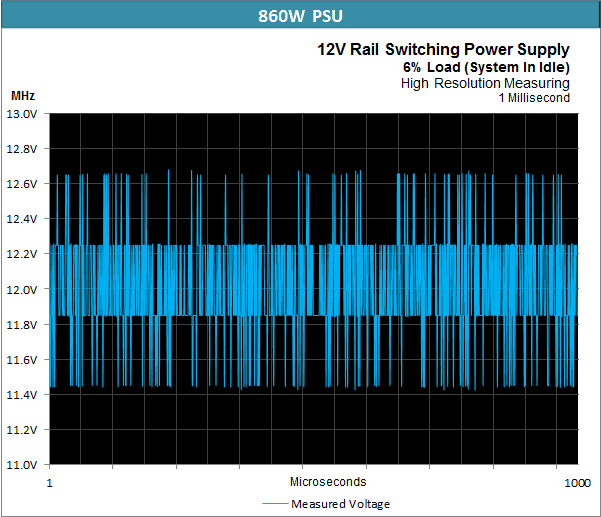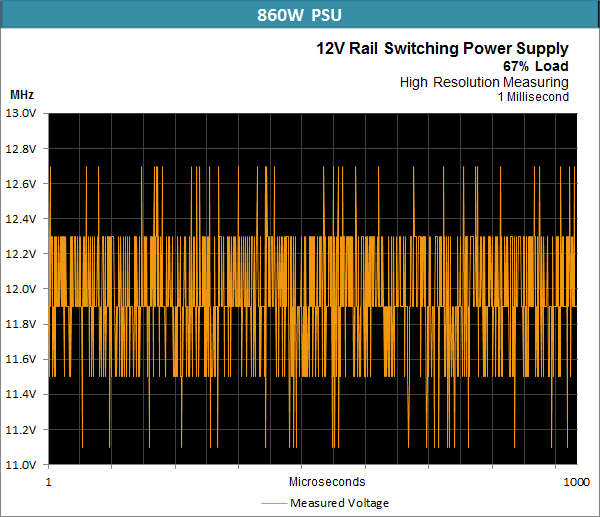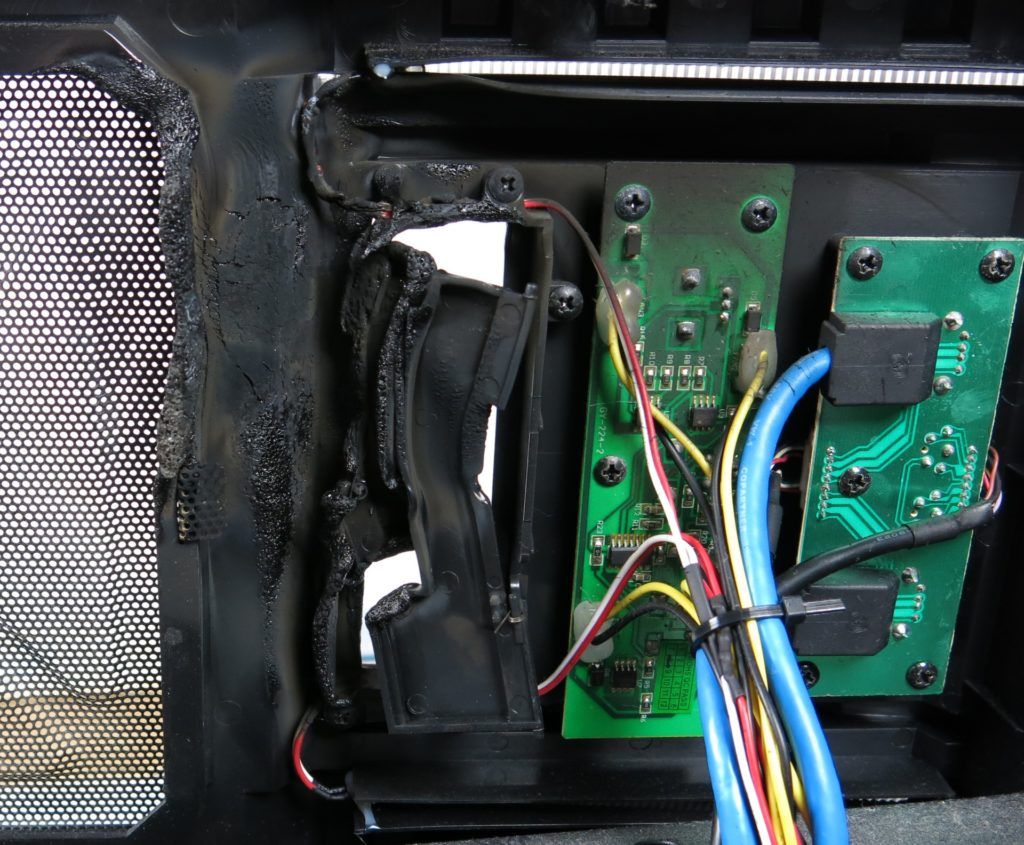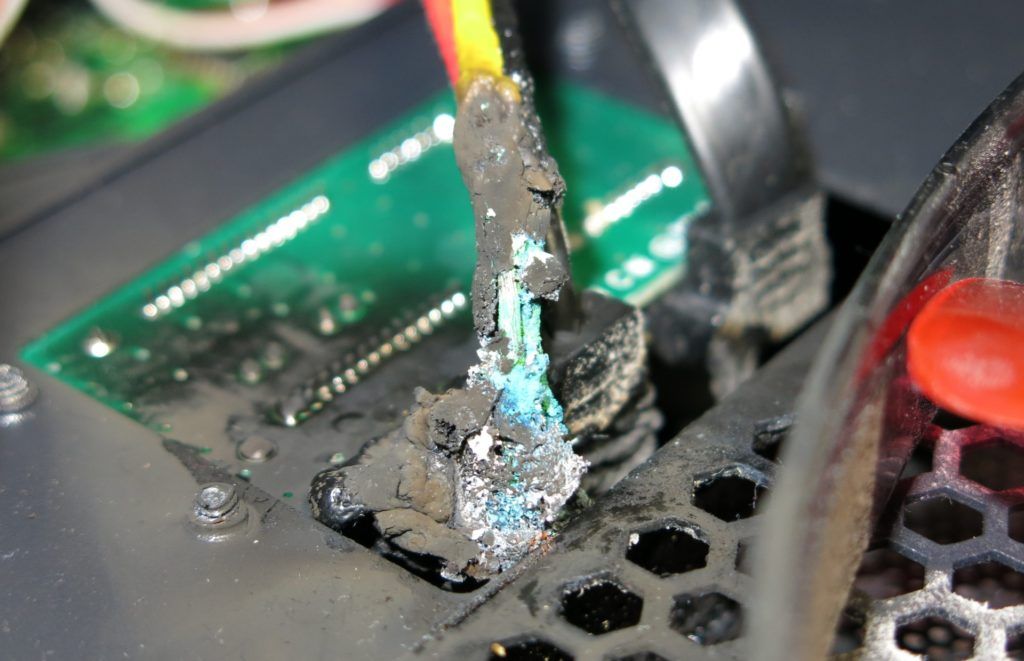The power supply side has it all in itself
Now we would have reached the power supply and want to deal with the problems that can await us on the secondary side of a modern power supply. But since I am not writing a power supply article, but a graphics card article, I have to pre-sort the content a little bit first. Therefore, in addition to the actual working principle, I am only interested in the secondary side and, in particular, the task and placement of the so-called secondary capacitors and the eternal discussion about the salting of the rails. For this I now use – with some intention – a digital 860-watt power supply of the upper middle class (Corsair AX860i) and have slightly rounded the measured voltage values to keep the graphics a little clearer.
As we already know, the current graphics cards produce extreme current peaks, which are very short ("spikes"), but can still follow each other several times in fractions of a second. I would also like to point out once again that the following is as general as possible and that it is also somewhat simplified or abstracted.
12 volts are not equal to 12 volts
A current ATX power supply is based on the principle of a switching power supply, which in itself is not a bad thing, as long as the voltage generated in the switching processes is sufficiently smoothed afterwards. If one looks at the 12-volt line provided in the power supply with a suitable oscillograph, then the expected constant DC voltage of 12 volts becomes a kind of alternating voltage mixture, the mean value of which is of course exactly within the framework of the ATX specifications. But only the average!
Now let's look at the almost loadless state of a digital power supply that operates at a slightly lower switching frequency. The smoothing is quite acceptable, even if we see here with higher dissolved measurement that there are no constant 12 volts available, even if the average value for the entire millisecond is quite exactly 12 volts.
But what happens when load peaks hit the already "pulsating" secondary side? We can see in the following graphic that even in this situation the ATX specifications are still being adhered to – at least as long as the mean is at stake. If we look at the measured millisecond, we end up with an average of about 11.85 volts.
The pulse-like charged capacitors of the secondary side therefore meet rather wild spikes, whose frequency can be almost twice as high as the switching frequency of the power supply. Often enough, it can happen that the next current peak hits a condesator before it could even be fully charged again! We recognize these unfortunate encounters from the brief dips in tension down to approx. 11.15 volts.
What do we learn from this?
Firstly, it is not only the capacity or the manufacturer's imprint that decides on the optimal functionality of the secondary capacitors, but above all a very good radio frequency behavior (low impedance at approx. 100 KHz), a high speed when charging and of course also good Ripple values. Digital power supplies in particular often have a slower control than analog solutions, so this circumstance could be even more important. More on that.
Secondly, as a result of these short-term voltage drops, e.g. a chip installed on the motherboard for voltage monitoring on the corresponding pin sets the flag for the PowerGood signal to Low, so that the motherboard switches off the power supply and not the UVP or OCP/OPP installed in the power supply, because the required trigger values have not yet been reached!
The supervisor chips of the power supplies have either not been chosen appropriately (for cheap power supplies) or one avoids such a fast response in terms of circuit sand. We were able to find out by evaluating the measurement protocols, where we also monitored the PowerGood signal. In the Radeon R9 295X2, which we like to try, the Platimax from Enermax, which is marked with 1200 watts, failed sporadically (as later also the Corsair AX 860i). The reason? In our case, the Platimax did not switch off due to overload of the 12-volt line, but the motherboard had the power supply switched off due to short-term voltage drops by losing the PowerGood signal.
A question of protection: Single vs. Multi-Rail
Before there is the usual heap and sting: Up to 40 amps on 12 volts, we would tolerate a single-rail power supply in good conscience, which then also runs out of a 500-watt power supply. On the one hand, this can still be secured quickly and relatively harmlessly and on the other hand, the connection of a high-performance graphics card is possible at any time. If one calculates that an R9 290X can hold a maximum of just under 250 watts, we are already at more than 20 amps and for the R9 295X2 at over 40 amps. Then it gets funny.
What happens when a single-rail power supply is short-circuited and the cables on the SATA strand are far too thin to pass through the required current for the response of the protective circuits, the following, own images show:
Looking for salvation in multi-rail circuits alone would surely also have jumped too short, as the current limits do not meet the requirements of the current graphics cards. We would argue for a PCI Express connection on 25 amps, as it would allow a cable with two 8-pin connectors to be easily supplied.
If you still need more (e.g. for things like the R9 295X2), you just have to use two rails with an 8-pin connector each. What is unfavorable, however, is that many supervisor chips that realize the OCP (overcurrent protection) in the power supplies can only secure up to 4 channels in total. This is not enough at the back and front if you want to secure the CPU and motherboard, as well as the entire drive connections separately. This is precisely where the digital power supplies, which offer a fairly flexible definition of the OCP per output, should take effect. However, the software required for this is usually still flawed and immature to really create a real sense of security. So what should be done?
Rule number one: Never oversize power supplies pointlessly! Always keep an eye on the total power required when choosing a single-rail power supply! In most cases, manufacturers offer up to 20 percent overload in the tips, which should not be exploited, but should never be left out of sight when relying on the protective circuits. Up to 500 watts of rated power, the single-rail world is also perfectly fine.
Rule number two: Check multi-rail power supplies beforehand for the maximum load of the rails AND your own requirements! For example, if you if you want to operate an R9 295X2 safely, then you have to use two separately monitored rails, which then also requires two individual PCI-Express connection cables. You can't get any further with double plugs. So pay attention to the cable assembly!
Rule number three: Digital power supplies are certainly an asset to the market, but the control is almost always slower than that of analog solutions. Then it is most important to have a suitable capacitor placement of the secondary side, in order to be able to cushion all load peaks sufficiently. Here we should wait for further development, because there are still many unresolved questions unanswered and the software problem not to be neglected. A solid power supply without additional sources of error will always be safer.
- 1 - Einführung und Projektvorhaben
- 2 - Grafikkarten und die Tricks mit der Leistungsaufnahme
- 3 - Leistungsaufnahme-Messung: Benötigte Technik
- 4 - Leistungsaufnahme-Messung: Praktische Umsetzung
- 5 - Radeon R9 295X als Netzteil-Killer? Myth busted!
- 6 - AWG was? Kabelsalat und Gegrilltes vom Chefkoch
- 7 - Schalten und Walten - Wir schauen ins Netzteil
- 8 - Bad caps, good caps? Die Mär vom japanischen Drachen.
- 9 - Zusammenfassung und Fazit





































Kommentieren